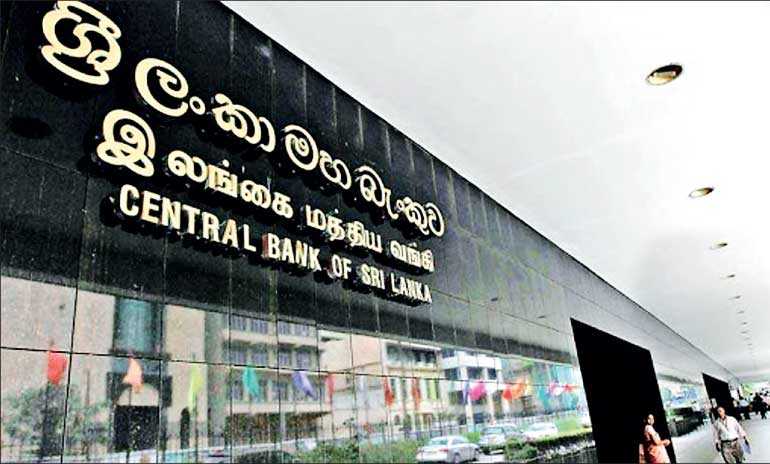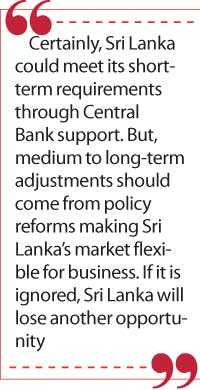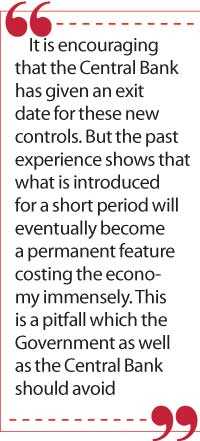Tuesday Mar 04, 2025
Tuesday Mar 04, 2025
Monday, 27 April 2020 00:50 - - {{hitsCtrl.values.hits}}

Gota’s Government which sought to get parliamentary majority at the General Elections of April had to shelve its plans and try for alternative power-gaining schemes. Undergraduates who had planned to graduate, get a job and raise a family had to postpone their plans at least by another year or so. Hoteliers who had hoped to make a quick recovery after the debacle to their trade following the Easter bombings in April last year have to seek Government’s bailout now. But these frustrations are nothing compared to what the Central Bank is undergoing today
One unintended consequence of COVID-19 has been the frustration that was caused to those with future plans. Employees of private banks who had planned to enjoy a holiday with family in Bali or Phuket after they get April bonus have not been able even to step outside their homes with family members. 
Gota’s Government which sought to get parliamentary majority at the General Elections of April had to shelve its plans and try for alternative power-gaining schemes. Undergraduates who had planned to graduate, get a job and raise a family had to postpone their plans at least by another year or so. Hoteliers who had hoped to make a quick recovery after the debacle to their trade following the Easter bombings in April last year have to seek Government’s bailout now.
But these frustrations are nothing compared to what the Central Bank is undergoing today.
Central Bank is the biggest loser
The Central Bank had announced some three years ago that it would change from the money supply controlling monetary policy platform to an inflation targeting framework.
I covered this when it was amplified to the public in a memorial oration in Colombo by the Bank’s Senior Deputy Governor, Dr Nandalal Weerasinghe, in November 2017 in an article in this series (available at: http://www.ft.lk/columns/Central-Bank-s-move-to-flexible-inflation-targeting-Wide-public-education-is-needed/4-644096). The bank was in fact well into its target of maintaining inflation in the target corridor between 4 and 6% in the following two years.
Then, the bank had endorsed the previous Government’s strategy for taming the budget by raising the bar for revenue goals since there was limited prospect for curtailing expenditure, especially, the capital expenditure, without hurting the economy. The bank had presented this in a new style Infographic in its annual report for 2018 (p 191).
Macroeconomic stability was gradually being restored and the bank had even upgraded its growth targets from around 3% to 4% over the medium term. All these plans of the bank have now been thwarted by the unexpected onslaught on the economy by the prolonged global pandemic now code-named COVID-19.
Covidonomics: Bring Keynes back to life
One good thing that has come out of COVID-19 is Covidonomics – the policy consensus that is being practiced throughout the globe to resuscitate the near-dead economies in the respective countries. This is to be contrasted with Washington Consensus that became the vogue in late 1980s as the way out for crisis-stricken developing countries. It was widely misunderstood, disputed, rejected, and not followed in sincerity it deserved. Hence, by the turn of the century, it was a dead animal, though even today, some opponents to it are still flogging it as if it is the reigning economic consensus of the day. 
Washington Consensus advocated for market reforms to facilitate the private initiatives to take economies to prosperity. Covidonomics, in contrast, has placed the Government at the steering wheel to drive the economies out of the deep depths to which they have fallen.
In essence, Covidonomics suggests that the governments should flood their economies with moneys – in the form of handouts, subsidies or loans or all or a part of these in a combo – so that people who matter in running an economy will get a money stimulus. This is the old Keynesian prescription for driving an economy when it is temporarily down due to a fall in the demand for its potential output. It became popular as a policy strategy after the World War II and was used increasingly whenever the global economy was hit by deep economic crises such as the one in 2007/9.
Keynes’ magic wand to quick prosperity
Keynes presented his thesis in response to the economic depression that hit the world in early 1930s in a path-breaking book he published in 1936 under the title ‘The General Theory of Employment, Interest, and Money’.
What he said was that if the economy is not performing at the optimal level due to a deficiency in demand, the Government can step in and create a demand for the output by increasing the Government expenditure levels. To finance the increased expenditure, it can get the Central Bank of the country to print new money and release to the Government.
Multiplier effect on generating a bigger income
This expenditure will generate a bigger amount of output in a series of cycles when people spend the new money they would get from the Government after setting aside some as savings. For instance, 100 rupees spent by the Government will immediately increase the income of people by 100 rupees. But if they save 20% out of that income, in the second cycle they would spend not 100 but 80. Those who got that 80 as income would spend only 64 after saving 20% of that income which amounts to 16. Those who got 64 as new income would spend 51.20 creating a new income in the system. This will continue until the whole of the original amount is saved by people in a series of cycles creating a much bigger amount of new income.
The rate at which this new income is created is called the multiplier and in our example in which people would save 20% of their income at a constant ratio, the multiplier would be five times of the original amount the Government has spent. That amounts to 500 rupees. Since income goes up by five times, it is therefore a sure way for a country to attain economic prosperity quickly by spending a smaller amount.
Keynesian prescription appealing to political leaders
Naturally, this type of promise would appeal to any political leader who is charged with the responsibility for taking his people to prosperity within the shortest time possible. This was the reason for the Keynesian promise to be popular among political leaders after the World War II. Sri Lanka’s first Finance Minister, J.R. Jayewardene, according to his biographers, was fully convinced of its validity after he had read ‘The General Theory’ some time in 1942. 
This was evident from the speech he delivered at the opening of the new Central Bank in August 1950. Emphasising that ‘money was made for man and not man for money’, he said that money should be used for the economic and social development of the people of the country. However, addressing the gathering after JR, Prime Minister D.S. Senanayake warned the new Central Bank not to abuse its money creating power because countries like China and Greece had got into trouble by doing so after the World War II. The examination of the Central Bank’s history shows that it has followed JR and his successors and not the wise counsel of the then head of the state.
Open economies run the risk of facing BOP deficits
One feature about Keynes’ model was that it was relevant only to economies which did not have international dealings. Since modern economies are such economies, there is a risk as well as a limitation in using his strategy to promote an economy.
This was well-understood even in 1949 when the Monetary Law Act, the law governing the Central Bank, was drafted. Its architect, John Exter, the first Governor of the Bank, warned those who think that Keynesian strategy could be used by a country like Sri Lanka for the development of the economy.
Ignored warning by John Exter
In the report which Exter submitted to the Government, known as the Exter Report, he warns as follows: “Much has been written in recent years of the benefits which a country can derive from policies such as deficit financing and cheap money in conditions of underemployment. Since Ceylon has chronic underemployment, it might naturally be asked whether the Central Bank will be able to eliminate it. Undoubtedly, the bank can help, but it cannot be too strongly emphasised that the efficacy of deficit financing and cheap money policies varies widely from country to country…
“In Ceylon, of a gross national product in 1948 of approximately 2 billion rupees, imports were 985 million rupees – a ratio of imports to national income of almost 50%. These figures indicate in a rather striking way why it is that in highly developed, self-sufficient countries policies such as deficit financing and expansion of private credit may be much more efficacious than they can be in underdeveloped countries that are largely dependent on foreign trade. This should serve as a warning to those who might hope that some of the policies growing out of Keynesian economics can be uncritically adapted to Ceylon.”
Making new mistakes to solve previous mistakes
What this means is that in an open economy with international trade the Keynesian type of stimulating policies via deficit budgets and cheap money would leak out of the country through imports creating balance of payments deficits and consequently pressure for the domestic currency to lose its international value.
Disregarding this warning, Sri Lanka adopted deficit budgets year after year. When it was clear that it led to balance of payments deficits putting pressure on the exchange rate to depreciate, the Sri Lanka Government clamped prohibitive import and exchange controls on the economy. Though it was considered as a solution, it was the root cause for a series of other problems. Import and exchange controls created a shortage of goods in the market causing prices to go up.
To prevent prices from going up, price controls were introduced. Since price controls gave rise to black markets, a compulsory rationing system was introduced to distribute the essential goods among the needy people. Rationing led to formation of queues and preparation of waiting lists to distribute goods. It starved industries of essential raw materials leading to an economic slump and unemployment. To get import and exchange licenses, firms had to employ full-time pushers. They used underhand tactics to get the licences issued making bribery and corruption a rampant activity. All these economic mishaps could have been avoided had the Government, in the first place, listened to Exter’s advice and refrained itself from resorting to Keynesian type stimulation policies.
Full burden of adjustment to be borne by the Central Bank
Covidonomics being adopted by Sri Lanka has required the Central Bank to bear the full burden of financing the cash starved economy. The measures adopted by the Government to prevent the spread of COVID-19 and bring it under control have brought a virtual standstill to economic activities. There is a cashflow problem being faced by the self-employed to the big corporates making them cry out for financial helps from the Government.
However, the Sri Lanka Government is unable to meet this demand due to two reasons. First, it has no space to do so because it is already facing budgetary problems due to ballooning of expenditure on one side and slow-growing revenue on the other. The budget deficit is estimated to be around 7% of GDP in 2019. This is projected to accelerate to a level of about 10% in 2020.
Government has no space to help the economy
With such a sick budget which is chronically ill for some time, the Government is not in a position to provide any support to distressed businesses. Second, the tax concessions offered by the present Government when it was elected to power in November 2019 to income tax and VAT payers are estimated to take a slice of about Rs. 500 to 600 billion out of the Government’s estimated revenue. This has made the Government a virtual lame-duck when it comes to providing relief measures to businesses.
In the circumstances, there is no other option except using the Central Bank’s money for the Government’s expenditure programmes. The bank has accommodated it liberally by increasing its reserve money base – an index for money printing by a central bank – from Rs. 933 billion at end-2019 to Rs. 1035 billion as on 23 April 2020. This is a massive increase in the reserve money base by Rs. 102 billion within a matter of slightly less than four months. Out of this Rs. 102 billion, Rs. 67 billion has been created within the first three weeks of April.
Prospect of a future monetary explosion
This is a monetary explosion and as Exter warned, it would be reflected in a bigger deficit in the balance of payments. To avoid it, the Central Bank together with the Government has introduced import and exchange controls on what it has termed as inessential imports valid for three months.
It is encouraging that the Central Bank has given an exit date for these new controls. But the past experience shows that what is introduced for a short period will eventually become a permanent feature costing the economy immensely. This is a pitfall which the Government as well as the Central Bank should avoid.
That poor Sri Lanka Government
Covidonomics thus equips the Government with a strategy to respond to the call from the business. Governments of Australia and New Zealand could easily do so because they have the necessary fiscal space. Japan can do it because it can issue its own bonds denominated in Yen to savings-glutted Japanese household sector. USA has no difficulty because it is the world’s unofficial central banker nation and therefore could print dollars to finance it without causing domestic inflation. China too has no difficulty in meeting this demand with its massive foreign exchange reserves amounting to about $ 4 trillion.
But Sri Lanka is in a bad wicket in this game because it neither has the needed fiscal space nor the ability to create money without causing domestic inflation and deficits in the balance of payments. This latter will put pressure on the exchange rate to depreciate, unless the country could raise new foreign loans at a higher yield rate now due to the country being downgraded by international rating agencies. It would also add to the foreign debt stock creating debt repayment issues for future taxpayers.
Policy reforms are the way out
Certainly, Sri Lanka could meet its short-term requirements through Central Bank support. But, medium to long-term adjustments should come from policy reforms making Sri Lanka’s market flexible for business. If it is ignored, Sri Lanka will lose another opportunity.
(The writer, a former Deputy Governor of the Central Bank of Sri Lanka, can be reached at [email protected].)
Discover Kapruka, the leading online shopping platform in Sri Lanka, where you can conveniently send Gifts and Flowers to your loved ones for any event including Valentine ’s Day. Explore a wide range of popular Shopping Categories on Kapruka, including Toys, Groceries, Electronics, Birthday Cakes, Fruits, Chocolates, Flower Bouquets, Clothing, Watches, Lingerie, Gift Sets and Jewellery. Also if you’re interested in selling with Kapruka, Partner Central by Kapruka is the best solution to start with. Moreover, through Kapruka Global Shop, you can also enjoy the convenience of purchasing products from renowned platforms like Amazon and eBay and have them delivered to Sri Lanka.
Discover Kapruka, the leading online shopping platform in Sri Lanka, where you can conveniently send Gifts and Flowers to your loved ones for any event including Valentine ’s Day. Explore a wide range of popular Shopping Categories on Kapruka, including Toys, Groceries, Electronics, Birthday Cakes, Fruits, Chocolates, Flower Bouquets, Clothing, Watches, Lingerie, Gift Sets and Jewellery. Also if you’re interested in selling with Kapruka, Partner Central by Kapruka is the best solution to start with. Moreover, through Kapruka Global Shop, you can also enjoy the convenience of purchasing products from renowned platforms like Amazon and eBay and have them delivered to Sri Lanka.